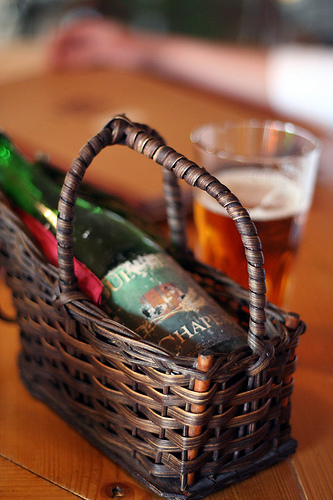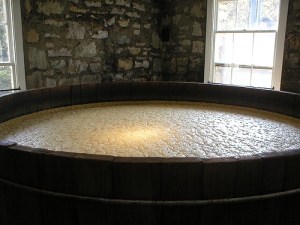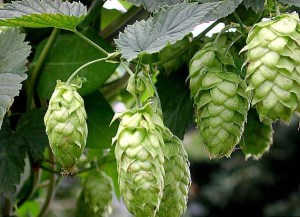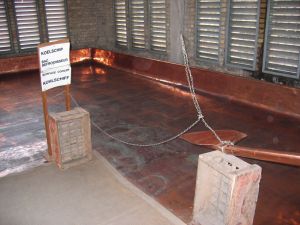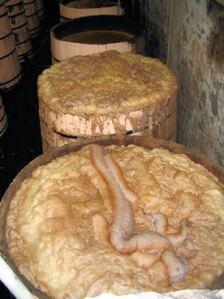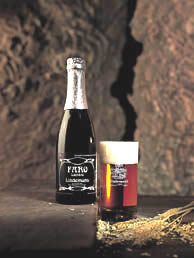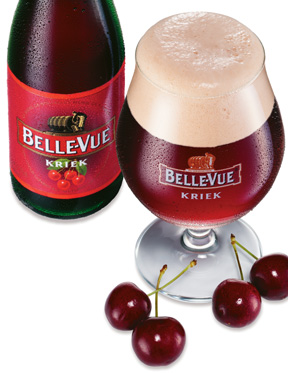I have developed an intense fascination, preoccupation … and obsession with wild yeast beers.
In my personal opinion, Lambics are quite possibly the most exciting and interesting style of beer. Ales and lagers are both fermented carefully with cultivated strands of brewer’s yeast -using tremendous control. On the other hand, Lambics are produced by spontaneous fermentation.
Although, my spontaneous nature has led to less than desired consequences in the past … I still pride myself for having such a free-spirited and adventurous personality. So what if I almost died jumping off an 80 foot cliff when I was in high school … I am still alive now, right?
I love the thrill of not knowing. I function well in chaos. I love jet setting at the very last minute. I am an adventurer and explorer. And this is why I love the concept of spontaneous fermentation.
The late and internationally renowned Beer Hunter, Michael Jackson, has referred to Lambics as the winiest of all the world’s beers.
As with many Belgian beers, Lambics are also subject to many regulations. In order to receive Lambic “certification” and label privileges, Lambics varieties must have Traditional Speciliaty Guaranteed (TSG) status.
The Traditional Speciality Guaranteed (TSG) is a trademark for an agricultural product or a foodstuff, which has a certain feature or a set of features, setting it clearly apart from other similar products or foodstuffs belonging to the same category. The product or foodstuff itmust be manufactured using traditional ingredients or must be characteristic for its traditional composition, production process, or processing reflecting a traditional type of manufacturing or processing.
So what exactly is all the traditional mumbo jumbo for Lambics?
The Lambic style can trace its roots back over 400 years, and has remained mostly unchanged from its introduction. The first written recipe is dated 1516.
Although it is impossible to confirm the origin of the word “Lambic” (“lambiek” in Flemish / Dutch), its most likely origin is the small town of Lembeek (“Lime Creek”) – a municipality close to Brussels. Today, Lambic production is concentrated in the western part of Brussels and in the nearby “Pajottenland”.
The definition of Lambic was set out in a series of Belgian Royal Decrees in the 1960’s and 70’s. These determined that Lambic must be made from at least 30% unmalted wheat at a gravity of no less than 11 Plato.
Lambic wort is usually composed of 60-70% barley malt and 30-40% unmalted wheat. Lambic beers are typically made from an original density (wort-strength) of 11.75-13.5 Plato (12.7 is the classic level) with an alcohol content of around 5.0-6.5% by volume.
Lambic beers use a variety of mashing regimes – some being very long and elaborate. The traditional method involves making two separate mashes and heating each in individual kettles.
At the boiling stage, Lambic beers use far more hops than conventional beers – sometimes up to 6 times as many hops. HOWEVER … Lambics are NOT bitter. (We will get to the flavor notes later). One of the MAJOR differentiating factors about Lambics is that they use AGED HOPS, typically aged up to three years.
The object of aging hops is to diminish their aroma, flavor, and bitterness. INSTEAD, the hops are being used solely for their secondary purpose – to ward against unwanted infections and excessive oxidation.
Unlike conventional beers which usually boil for an hour or so, the Lambic boil lasts anywhere from 3 to 6 hours. After the boil, conventional beers are usually cooled in a heat exchanger. Lambics are not. Instead, Lambic wort will spend the night in a coolship.
Then it is on to fermentation.
Unlike with conventional beers, No yeast is artificial added to Lambic wort. Instead, Lambic wort is exposed to the open air of the “Zennevalei” aka the Senne-valley. Wild yeast cells, including Bretanomyces bruxellensis and Bretanomyces lambicus (which are always in the open air in the environment of Brussels), come into the wort and eventually result in spontaneous fermentation.
Due to the spontaneous fermentation, Lambic can be brewed only in the “winter season” (October-May). In summertime, there are too much undesirable bacteria, which can infect the wort and interfere with the natural fermentation.
Most ales and lagers are produced using only a few strands of yeast, while Lambics are typically made with around 86 yeast strands.
As you can imagine, spontaneous fermentation is a very lengthy process. The microorganisms involved in the creation of Lambics must work in a specific sequence. Each microroganism depends on the metabolized products of its predecessors. It takes about two to three years for the entire process to complete and to produce a mature Lambic.
The varieties of Lambic include: Straight Lambic (Lambic Pure), Faro, Fruit, Mars … and MY ABSOLUTE FAVORITE, Gueuze.
Straight Lambic: Cloudy, uncarbonated (almost still), unsweetened and unblended draught beer. Generally three years old. Extremely hard to find. It is served in only one or two two cafés in Brussels and a handful in the area of production.
Faro: Unblended three-year-old lambic sweetened with rummy-tasting dark candy sugar and occasionally spiced. Also hard to find and typically found on draught. Sometimes available at Lambic cafés in a do-it-yourself version where sugar is added directly at the table by the drinker and crushed into the drink with a mortar. Faro was once the restorative for the working man in Brussels.
Mars: Traditionally referred to a weaker beer made from the second runnings of a Lambic brewing. It is no longer commercially produced.
Fruit: Lambic with the addition of whole fruit or syrup. Most common fruits include sour cherry (kriek), raspberry (framboise), peach (pêche), blackcurrant (cassis), grape (druif), or strawberry (aardbei). Rarer fruit lambic flavorings include apple (pomme), banana, pineapple, apricot, plum, cloudberry, and lemon. Fruit lambics are usually bottled with secondary fermentation. Lambic-based Kriek beers are the most traditional fruit brews.
Gueuze: Bottled, sparkling and easier to find. Made by blending young Lambic (6 months to 1 year old) with more mature vintages (2 to 3 years old). It is then bottled for a second fermentation (similar to Champagne and is actually bottled in Champagne bottles). The word Gueuze (hard “g”, and rhymes with “firs”) may have the same etymological origins as the English words gas and ghost, and the Flemish gist (“yeast”), referring to carbonation and rising bubbles.
Last spring – while drinking and eating my way through Chicago, I was introduced to the gueze. My first experience was with Lindeman’s Cuvee Rene – which absolutely blew my mind. I loved it so much, in fact, that I opted to drink Cuvee Rene for my last birthday (the quarter of a century celebration) in lieu of Champagne or sparkling wine. To this day, I find it very hard to choose between Gueuze and Champagne!
Now that I have posted the educational mumbo jumbo about Lambics … I look forward to tasting and blogging about some of my favorites in the (very) near future!
CHEERS!
SOURCES: Michael Jackson’s GREAT BEERS OF BELGIUM, Wikipedia
